Menu
When And How To Divide / Separate African Violet Leaf Babies From Mother Leaf
After waiting 3-4 months, you finally see tiny baby plantlets emerging from your African Violet leaf cuttings. You are now trying to decide whether you should separate the babies from the main leaf or wait a little while. This article will hopefully give you an idea of when it’s the right time to divide the African Violet plantlets and pot them up.
Should I remove the main mother leaf once the baby plantlets have emerged?
- It is absolutely fine if the mother is still attached to your baby plantlets, even if the plantlets seem be considerable in size.
- There is no need to remove the mother leaf.
- Actually, the plantlets and roots originate from the base of the mother leaf.
- The mother leaf provides support to the plantlets by keeping the plantlets upright.
- It does this by first sending our roots from the base of its own leaf; it anchors itself in the soil and then sends up a cluster of plantlets.
- These plantlets start to develop their own root system, but the roots are still weak and not strong enough to support the plantlet cluster, so the mother leaf plays this role.
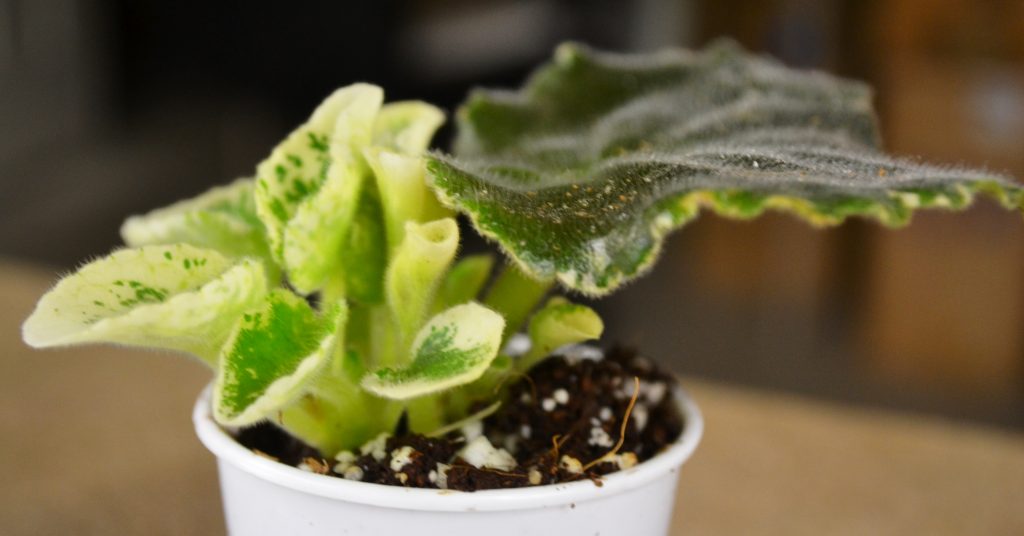
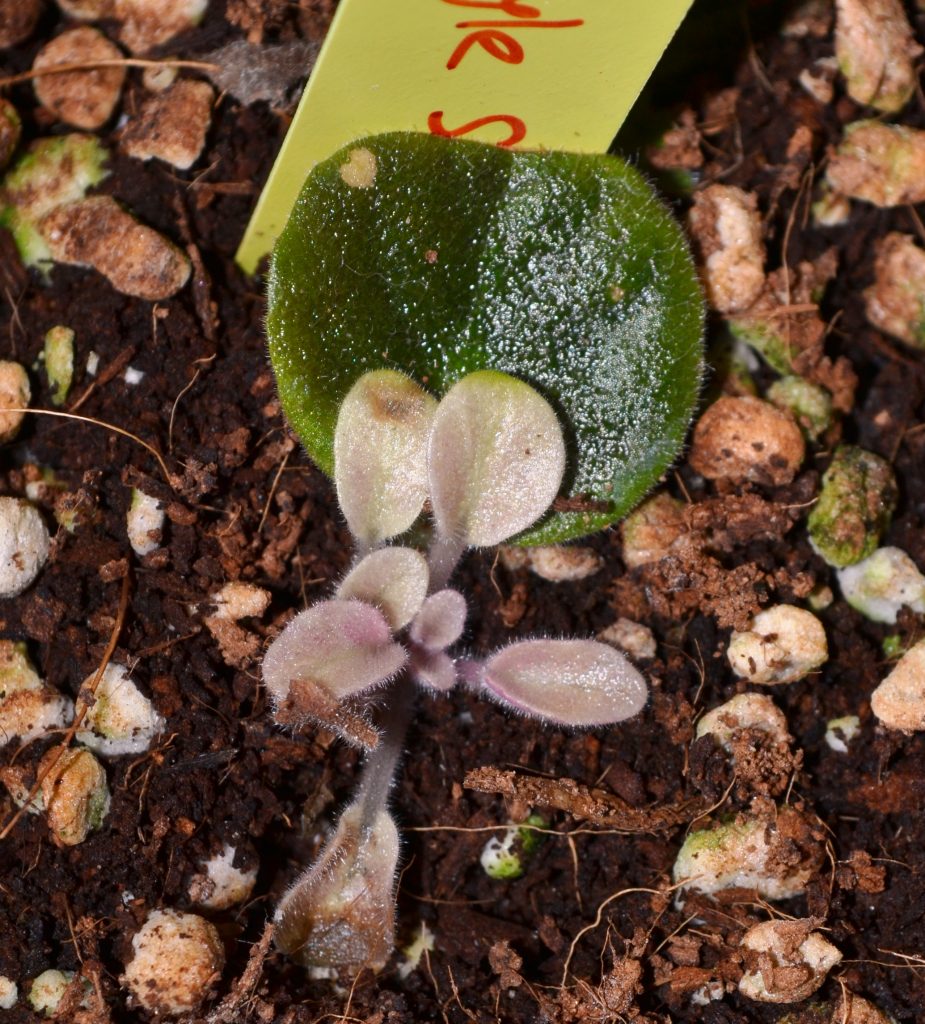

The main mother leaf has dried up, become mushy or has died, is that ok?
- Yes, many times depending upon environmental factors beyond our control, the main mother leaf may shrivel up, become mushy or just disintegrate leaving behind the baby plantlets.
- This is completely fine. If you can still see the dried or mushy leaf, you can gently pinch the top part of any remaining leaf blade and remove it.
- Below the top part of the leaf blade, the stem may still be green and have roots going deep down into the soil.
- Leave this stem as it still may be supporting the plantlet cluster.
- Even without the main mother leaf the baby African Violet plantlets will grow fine, as long as there is a strong root system developing below the soil.
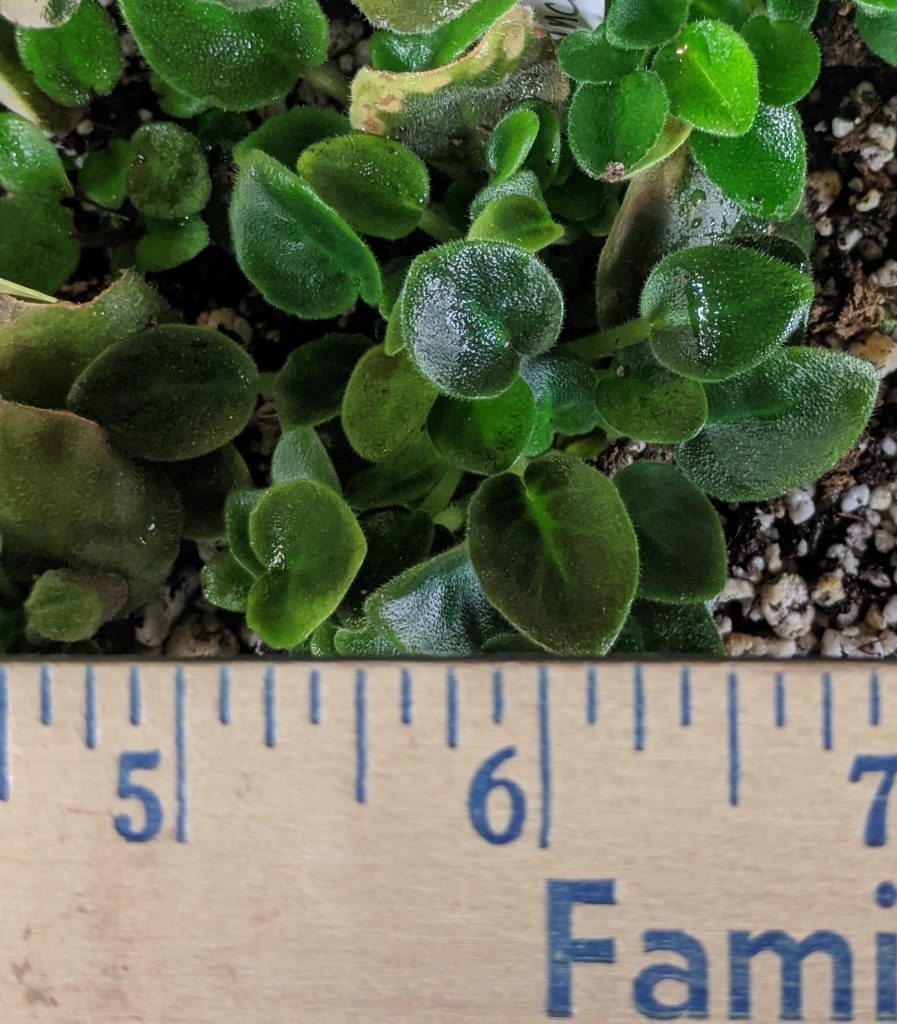
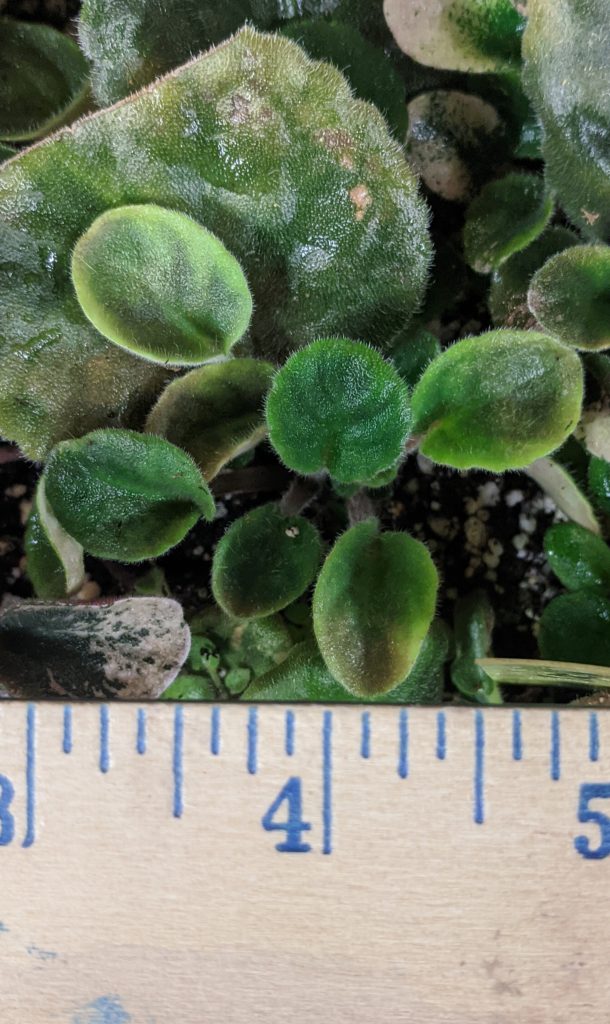
African Violet, perlite and other potting mixes shown below:
How to take care of African Violet baby plantlets when they are still attached to the main mother leaf?
- Once the baby African Violet plantlets emerge from above the soil, you can fertilize the plantlets with 1/4th to ½ the strength of fertilizer you would usually use with each watering.
- If the leaf set up was in a Ziploc bag, plastic container or humidity dome.
- You can start by hardening off the plantlets, before separating them from the mother leaf.
- Until now, the plantlets were growing in a high humidity environment, developing a root system.
- They now have to get used to the normal environmental conditions of your plant room.
- You can do this by periodically opening up the Ziploc bags, the containers or vents on the humidity domes with increasing frequency every week.
- This way you transition your plantlets from a high humidity environment to a relative humidity environment slowly over time.
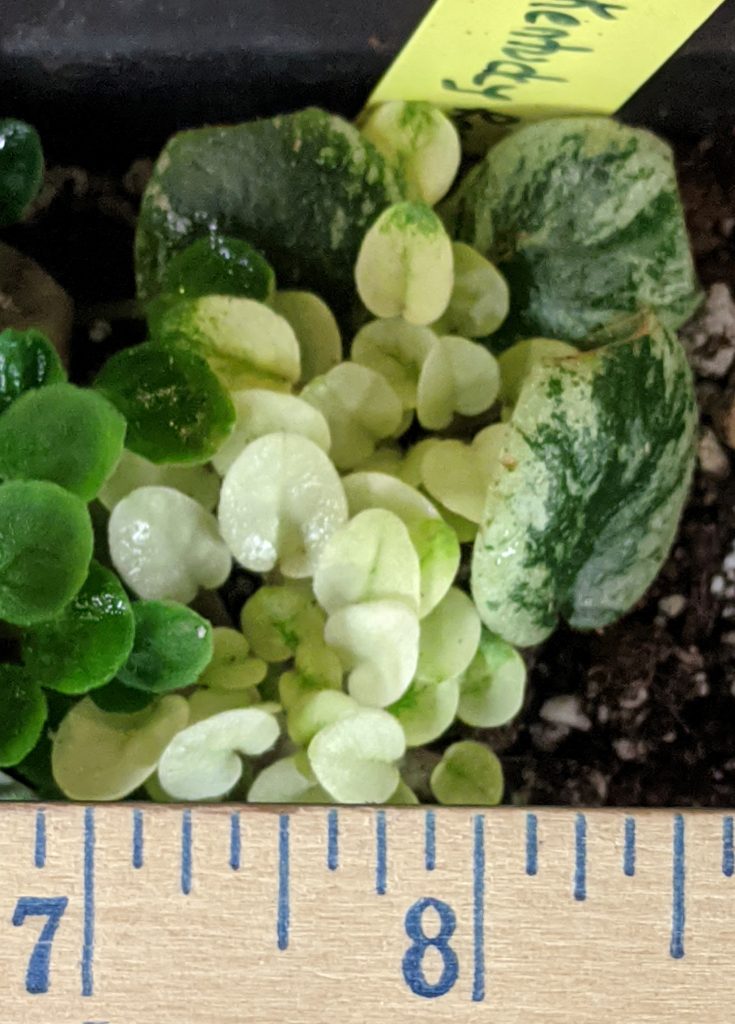
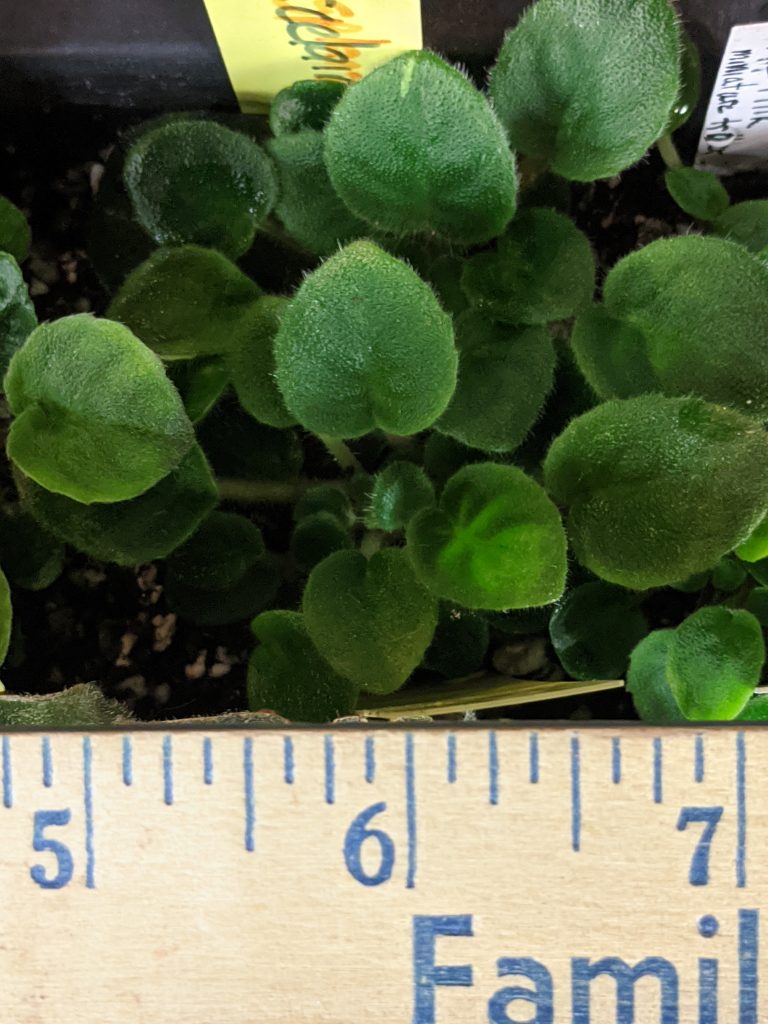
When to separate African Violet leaf baby plantlets from main mother leaf?
- First, you can check to see whether the plantlet cluster/leaf cutting have developed a strong root system. Gently tug the leaf/baby plantlet cluster and see if it is firmly anchored in the soil. If it is, this means your plantlets have developed a root system.
- Secondly, check to see the size of your baby plantlet leaves. If you have a semi-miniature or miniature African Violet leaves, the plantlets should have at least four dime sized leaves.
- This equals to each leaf being around 0.5”- 0.7” inches in diameter.
- If your plantlets are of a standard variety African Violet, then the leaves should be the size of a nickel, which is around 0.8” inches in diameter.
- Third, its best to wait till the mother leaf has died and you are left with slightly larger African Violet plantlets.
- Though, this does not always happen, its best to wait at least 3-4 months, before separating the baby plantlets from the main mother leaf.
How to separate the main cluster of African Violet leaf plantlets from the main mother leaf?
- First gently remove the leaf cutting/baby plantlet cluster from the soil. It will look like the images below:



- Second, visually inspect the leaf cutting/baby plantlet cluster.
- Try to identify the stem of the leaf and the point where the plantlet cluster seems to be attached to the leaf stem or leaf blade.
- There maybe two separate clusters of plantlets, one on the front side of the leaf and one on the reverse side of the leaf. As seen in the pictures below:



- Third, once you have identified where everything is, if you gently tug the mother leaf away from the baby plantlet clusters, they should separate easily.
- You should be left with the mother leaf with a large root system and the cluster of baby African Violet plantlets with their shallow root system. As seen in the pictures below:

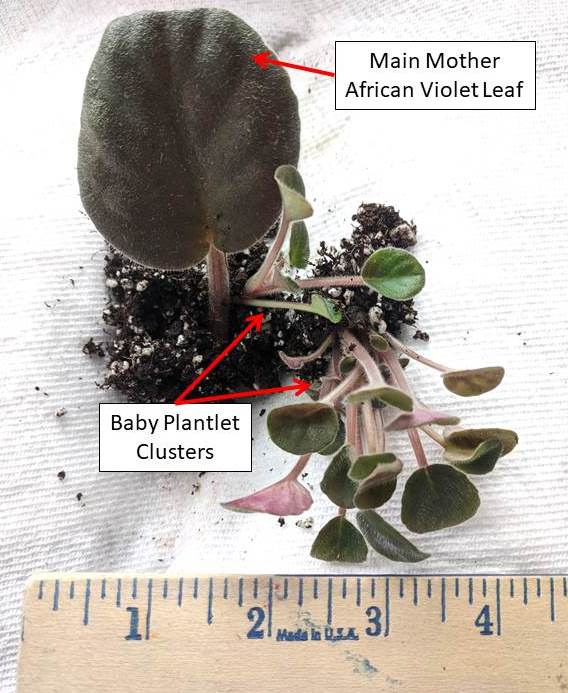



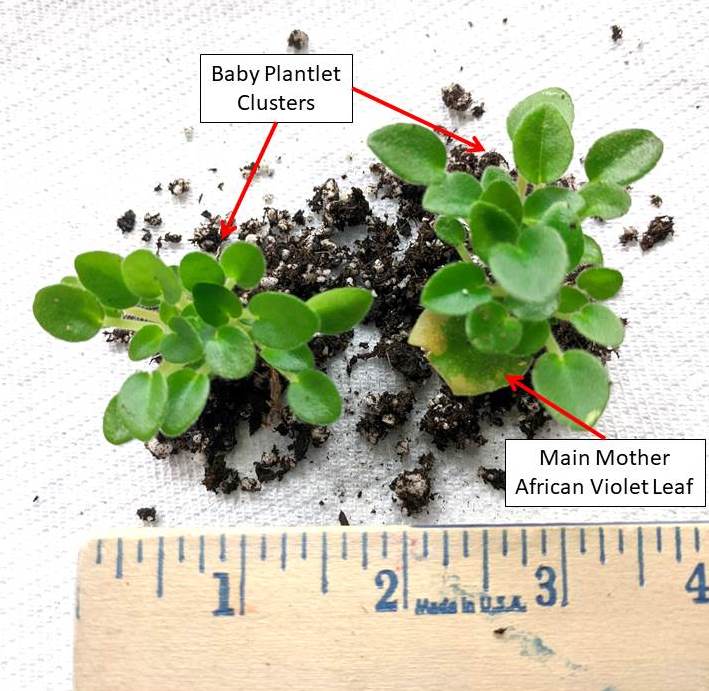
Examples of 2″ & 3″plastic pots, great to keep a few extra in your growing tools:
How to separate individual African Violet baby plantlets from the main cluster of leaf plantlets?
- Once you have separated the main mother leaf from the cluster of the baby plantlets.
- You can now go ahead and separate the baby plantlet cluster into individual baby plantlets.
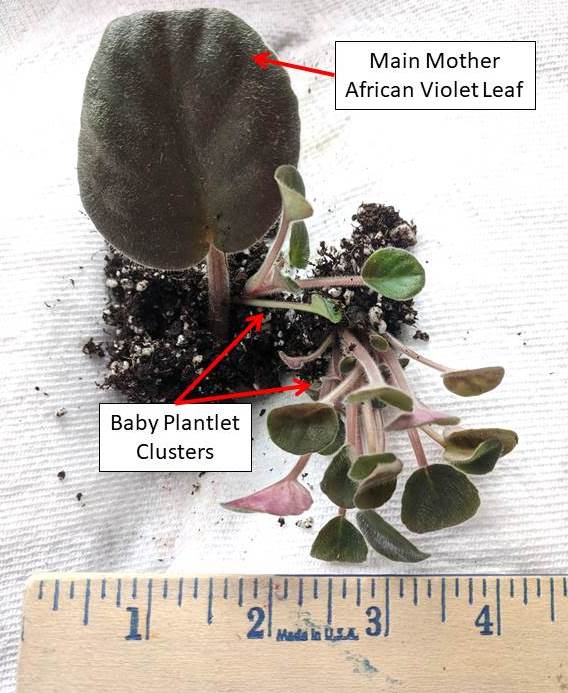


- Usually from a single African Violet leaf, you can obtain 4-5 individual separate baby plantlets.
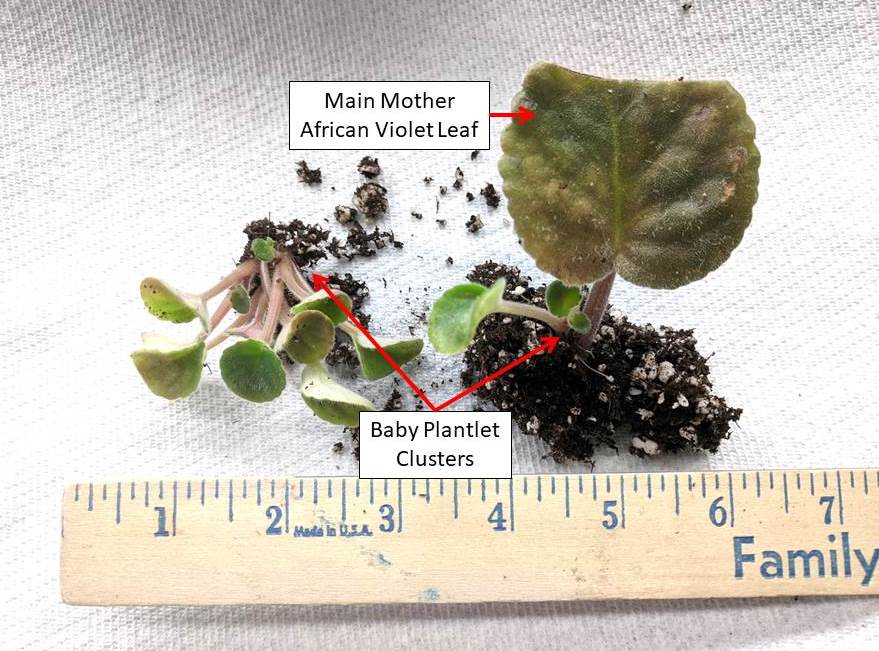


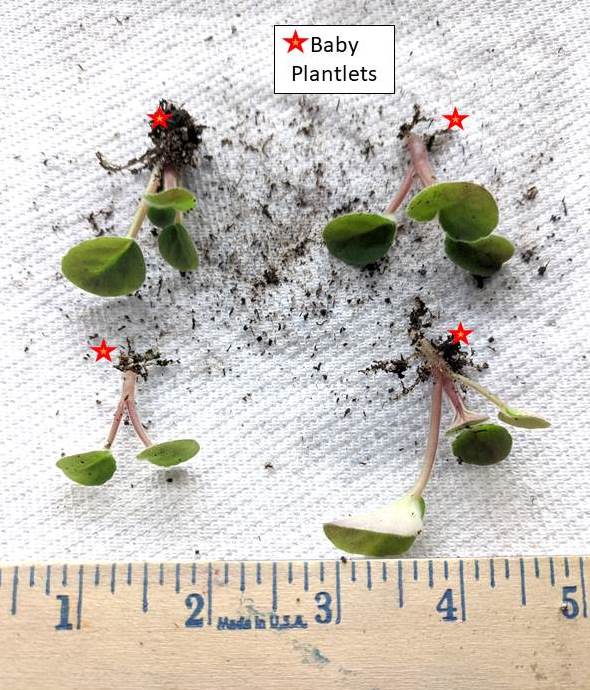
- Gently tug these stems away from each other and they should easily fall apart or separate away.
- Remember to visually inspect the cluster and you should see the main thin stems of the baby plantlets attached close to each other.
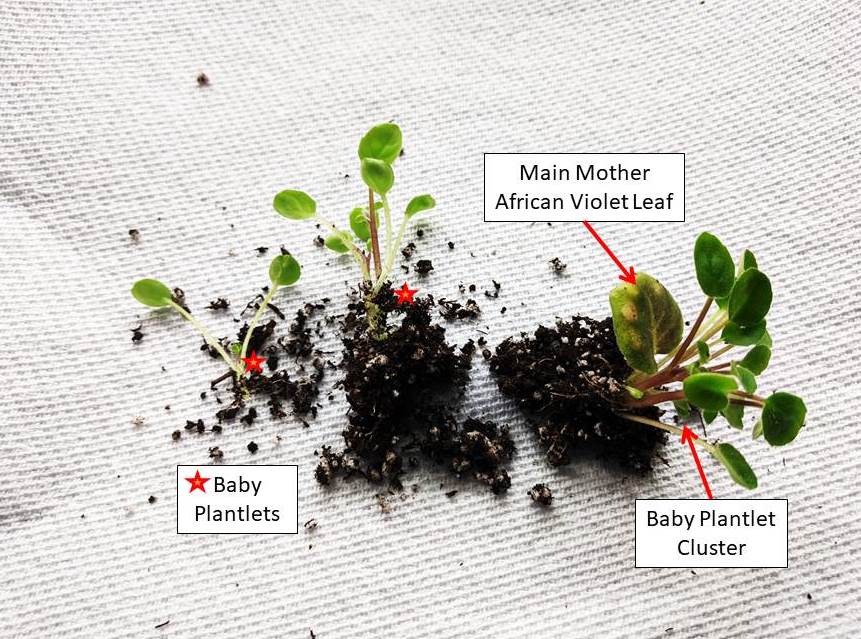
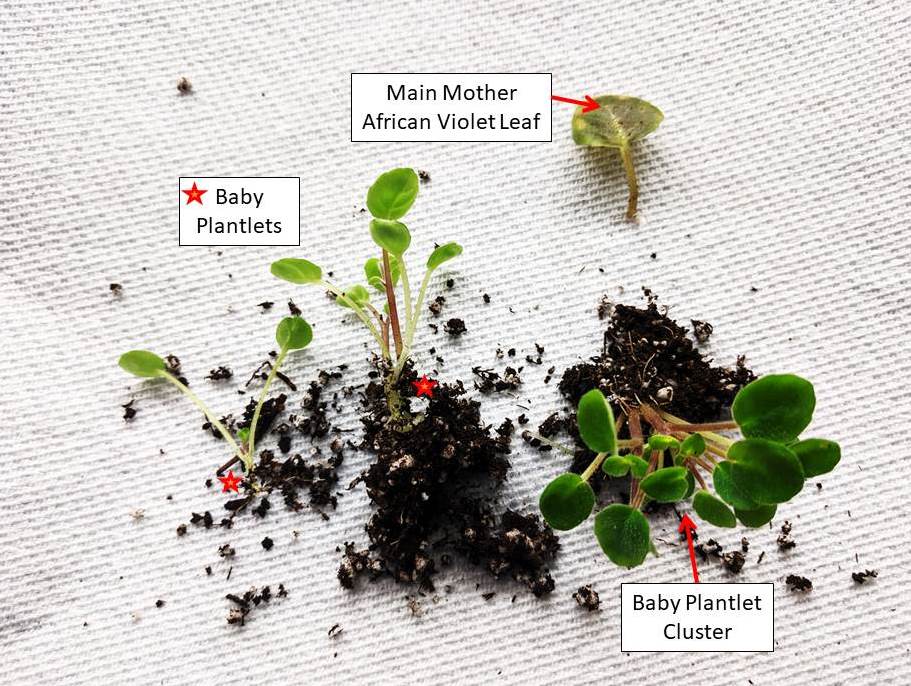
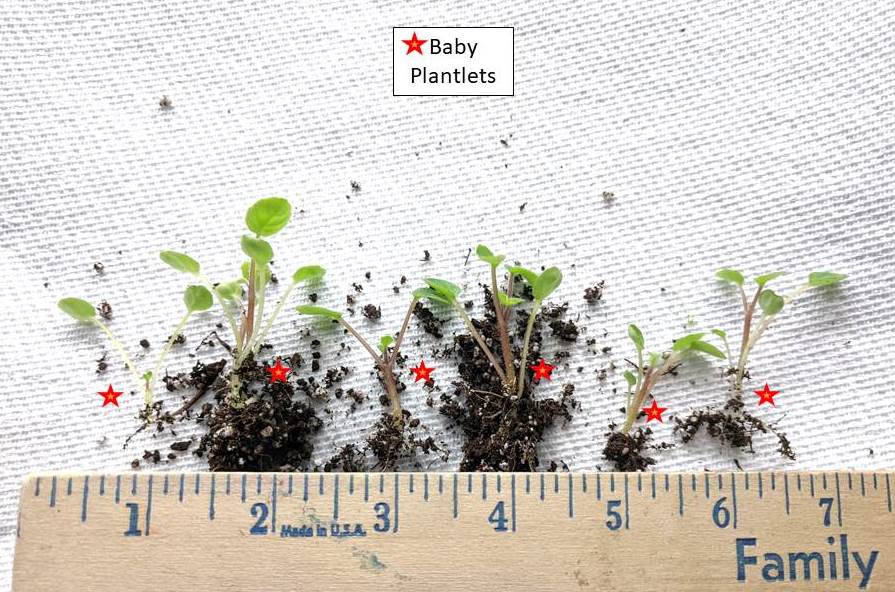

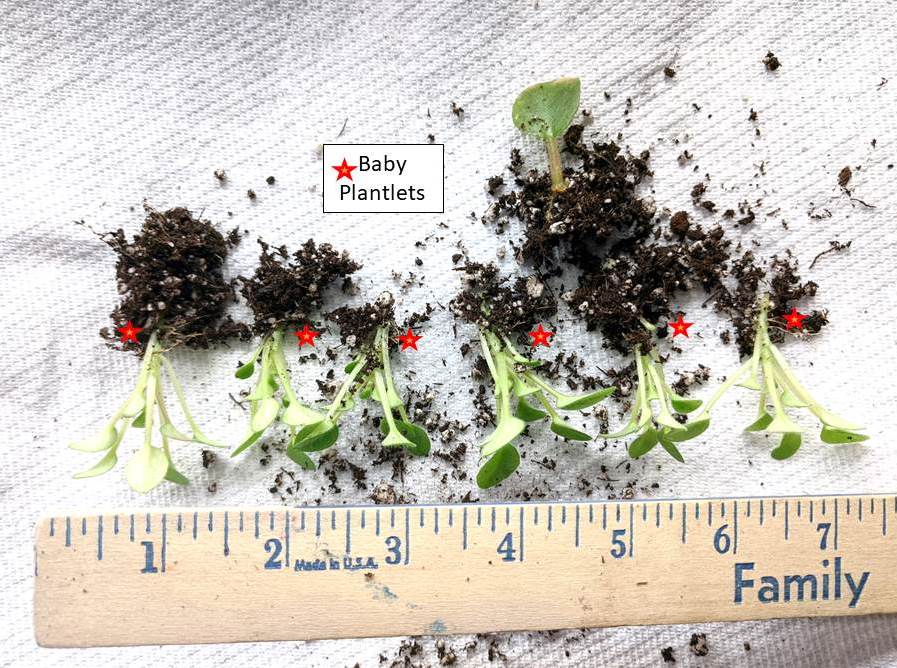
How to prepare soil to pot up African Violet leaf baby pantlets?
- I use the same soil mix for my baby plantlets as I use for my mature African Violet plants.
- This is an equal ratio of peat moss to perlite (1:1). You can mix 3 cups peat moss with 3 cups coarse perlite.
- Make sure to moisten the soil with room temperature water, mix both parts peat moss and perlite well.
- Keep the soil mix light, loose and airy so that the new roots can easily spread through the soil.
- This light soil, can also ensure that water can easily be drained out.
- Do not use dense compacted soil for African Violets.
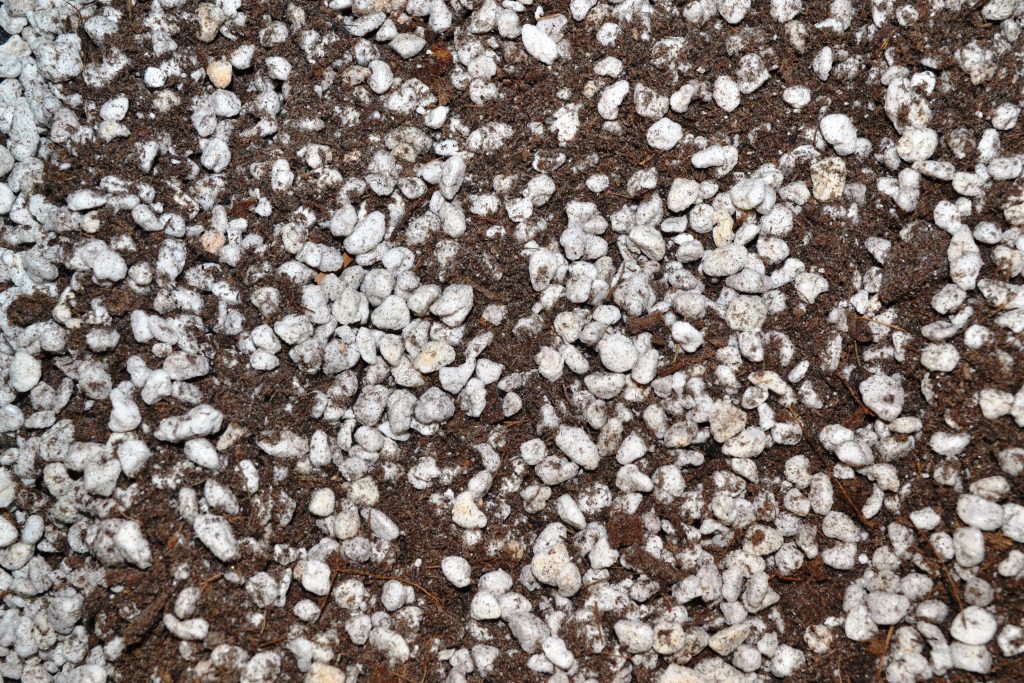
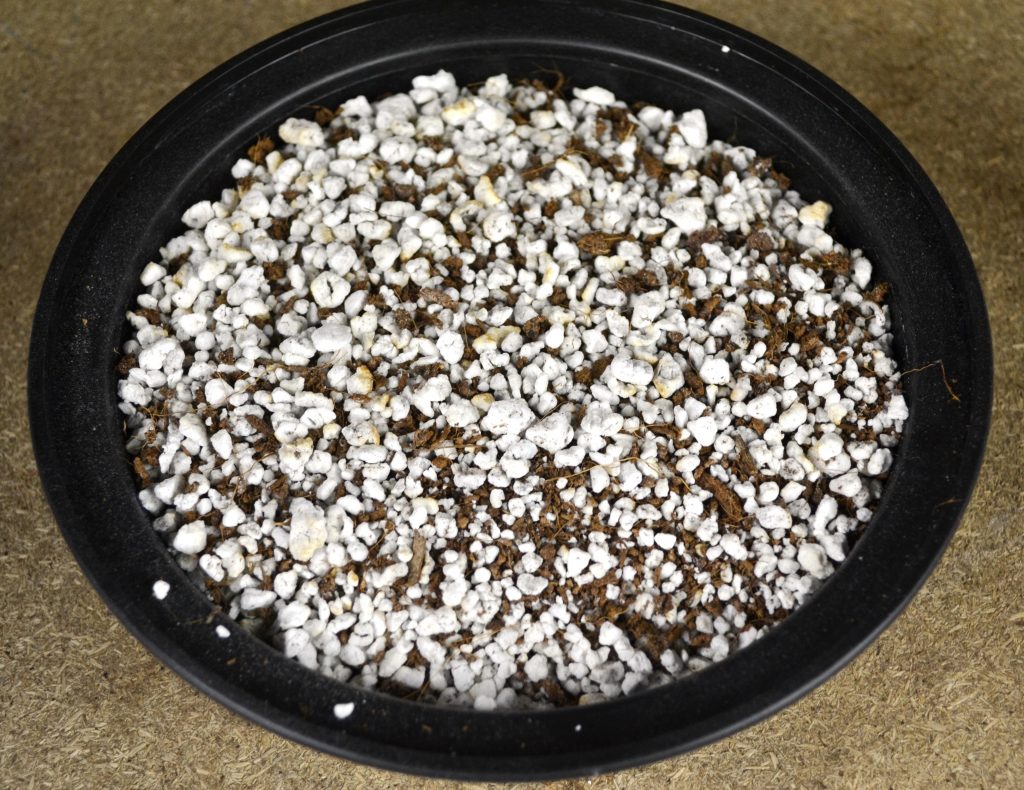
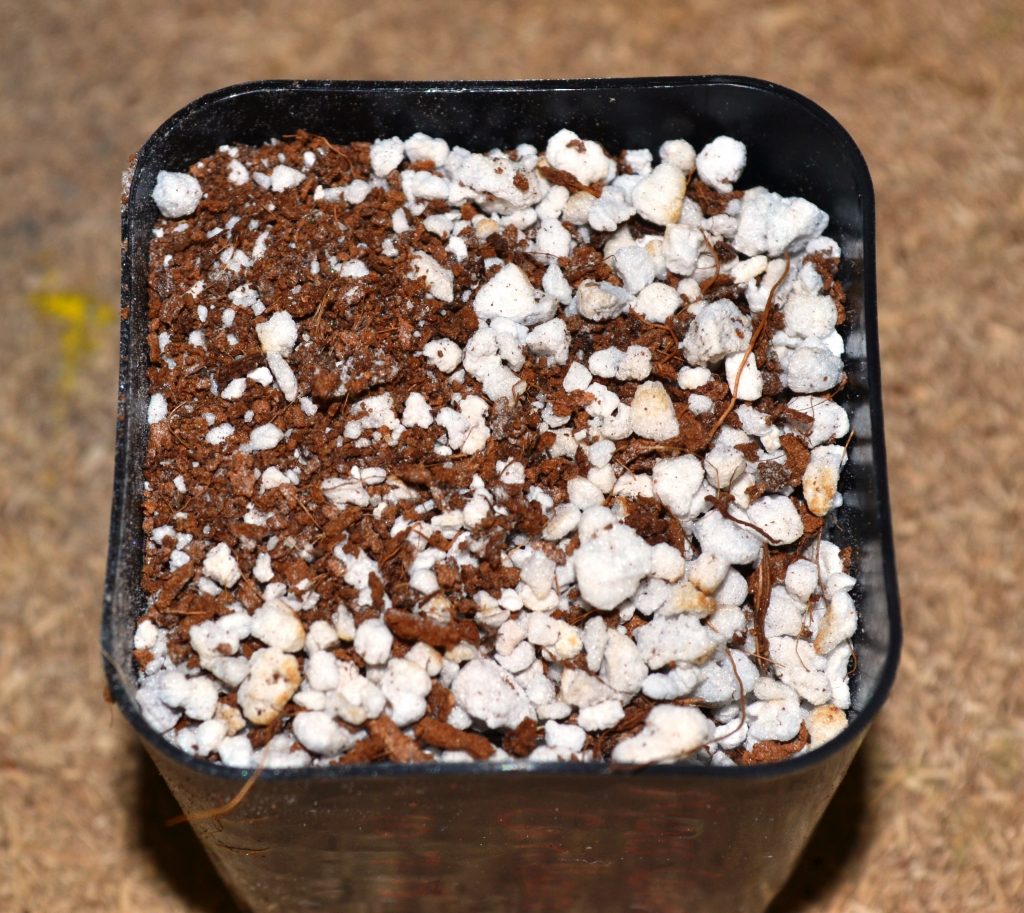
How to pot African Violet leaf baby plantlets?
- I use 2” plastic pots for each individual baby plantlet.
- You can add a thin layer of coarse perlite at the bottom of the pot to ensure better drainage (but that is optional).
- Fill the pot with the soil of choice using your hands or a spoon.
- Use a pencil or your finger to make a hole in the center of the soil mix.
- As seen in the pictures below.
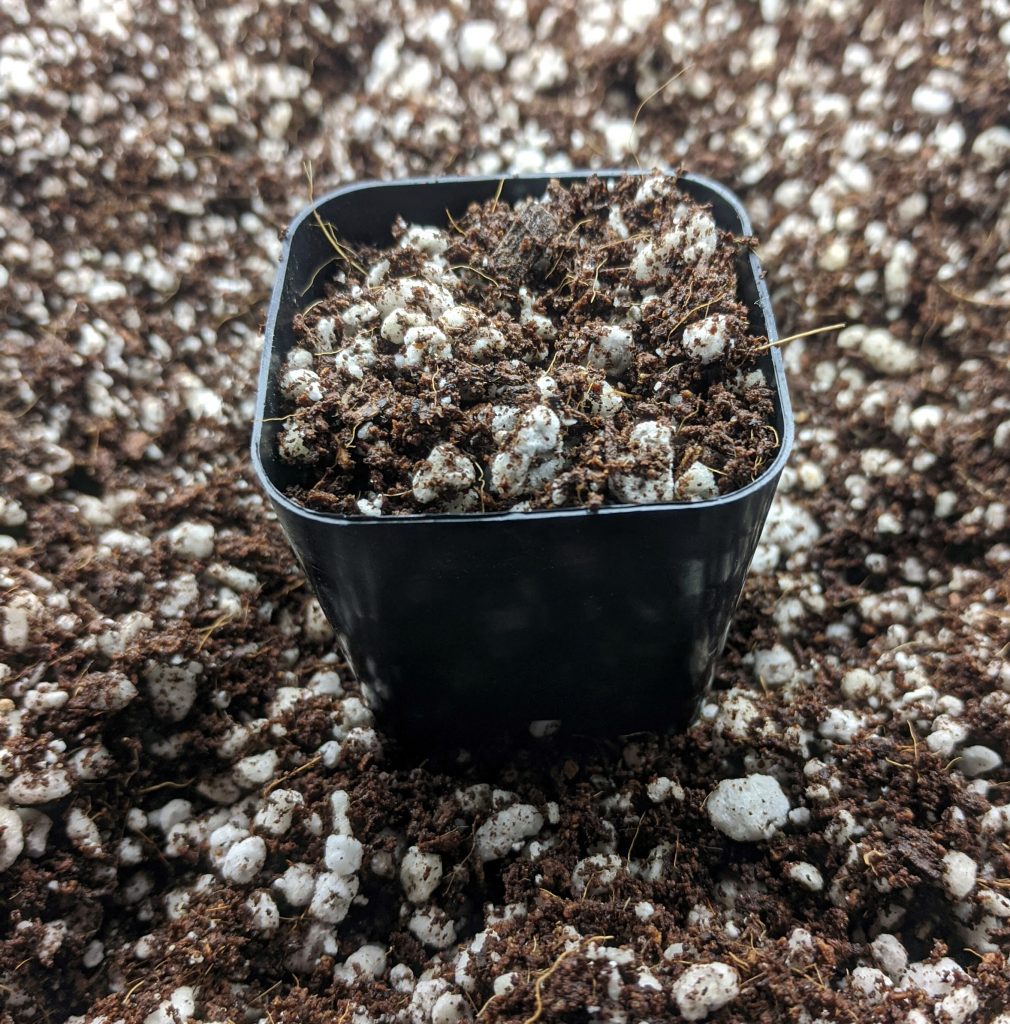
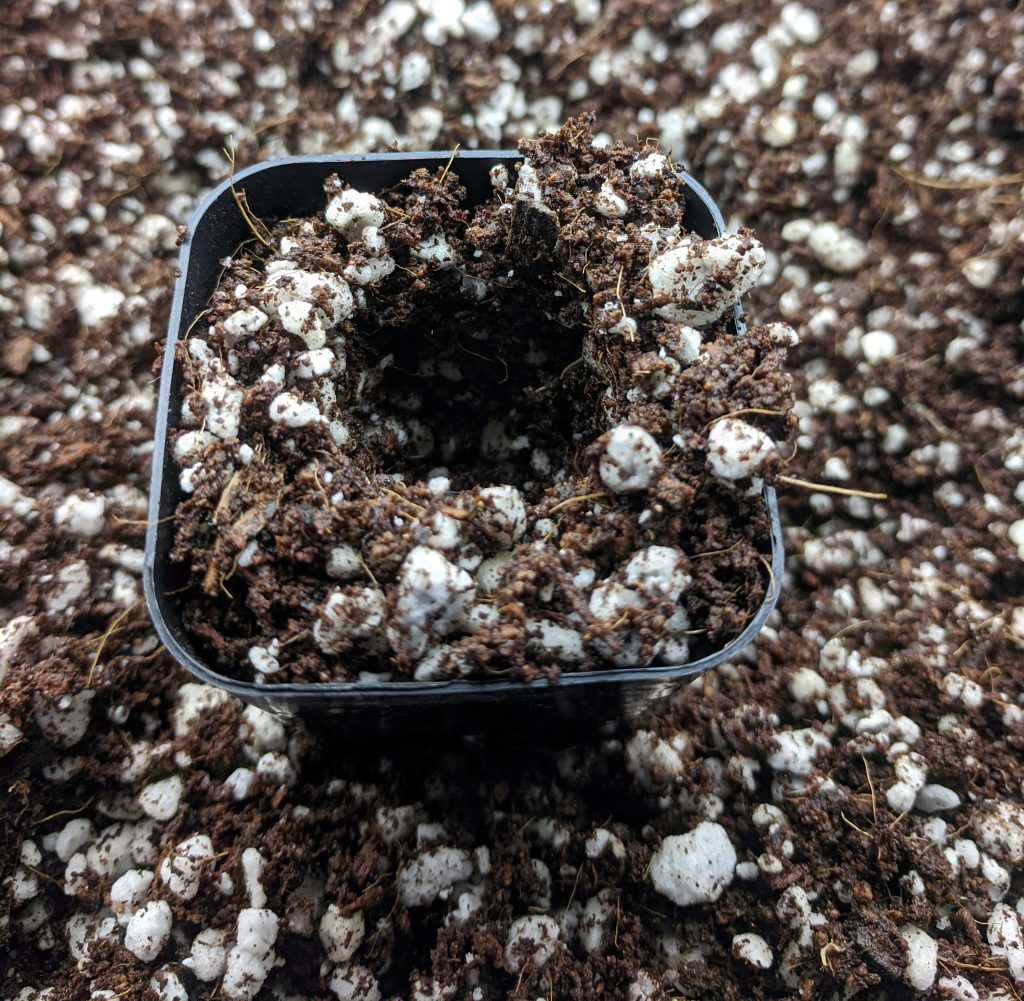
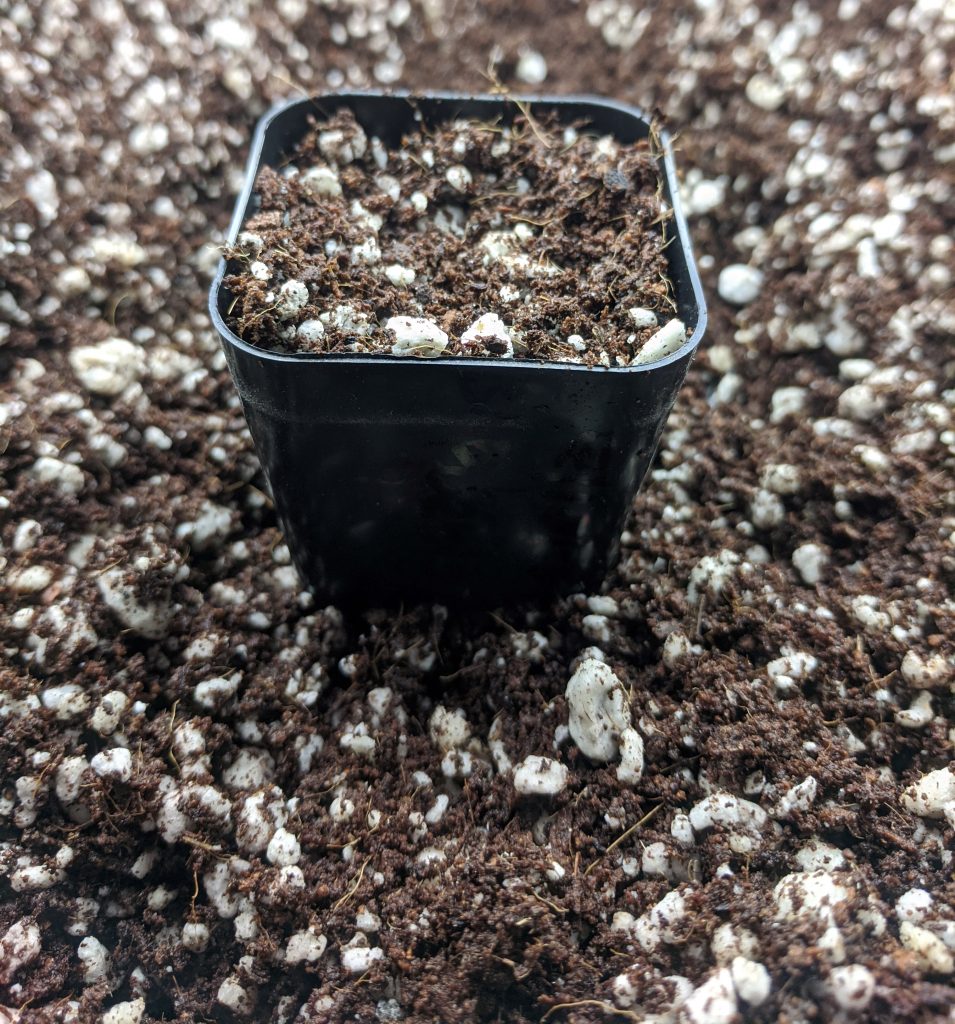
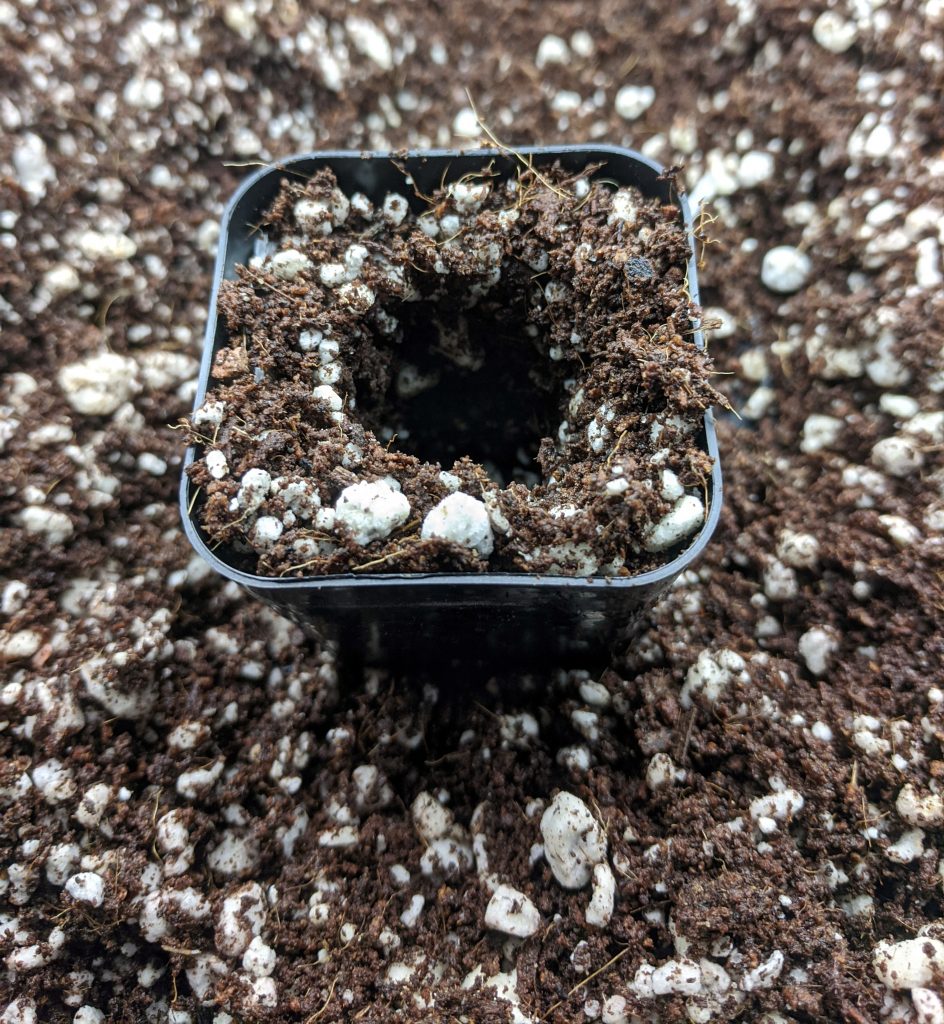
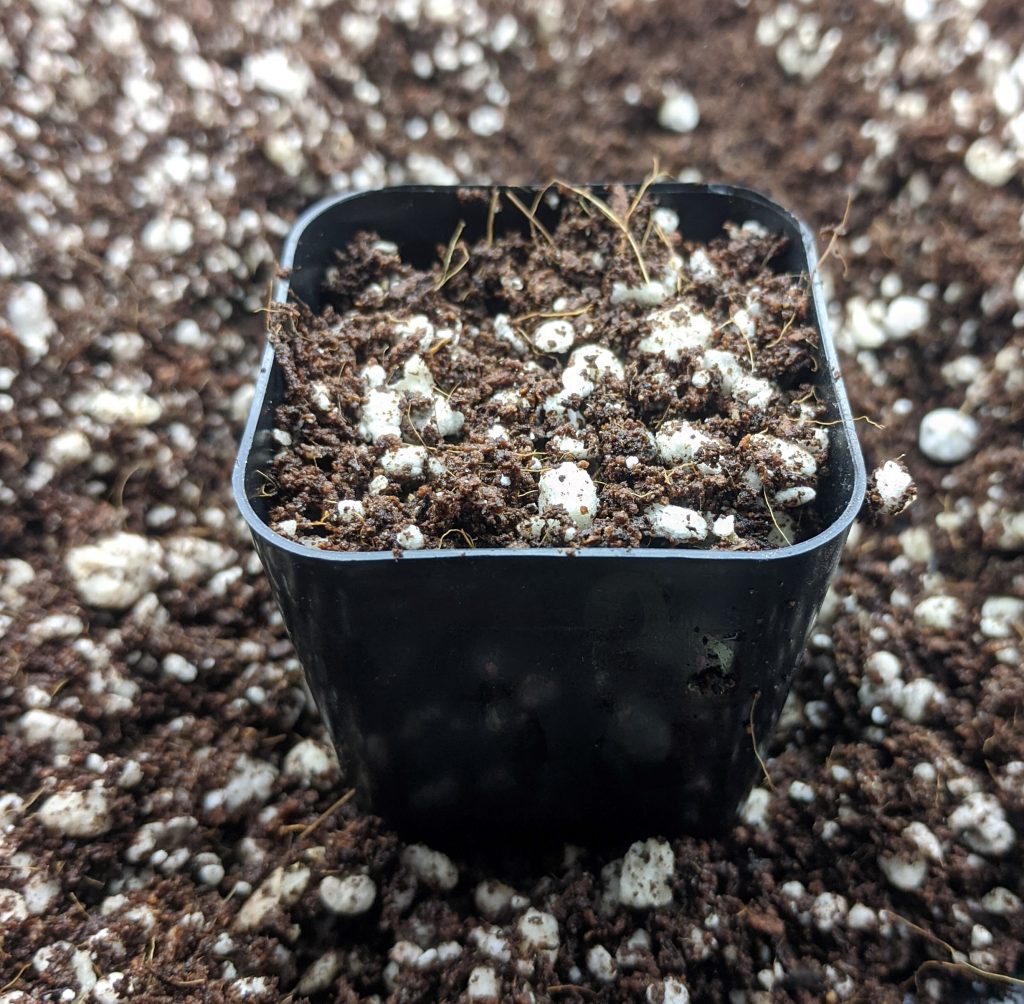
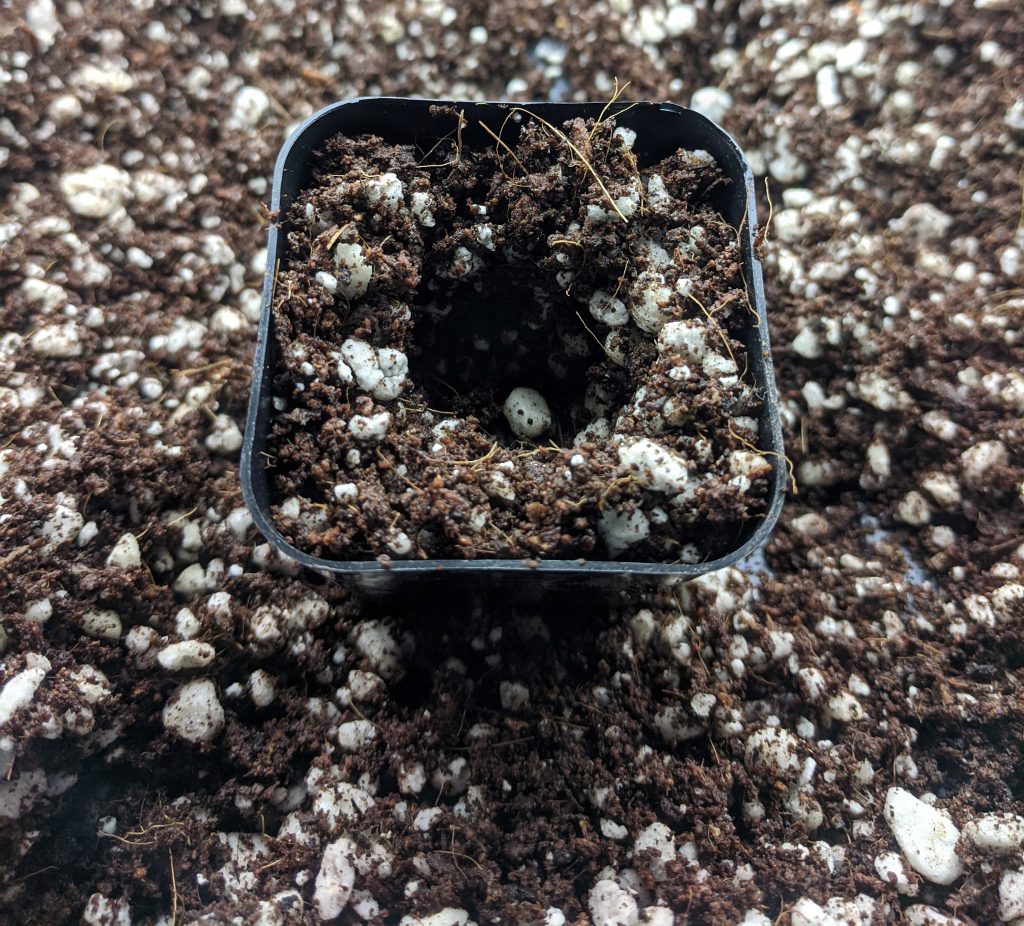
- Place the African Violet plantlet, its thin stem and its roots inside the center area of soil mix.
- Gently cover the roots /stem of plantlet with soil mix till the leaves just graze the soil or are slightly above the soil.
- Do not press down on the soil too much. Just lightly cover the plantlet with soil. As seen in the pictures below:
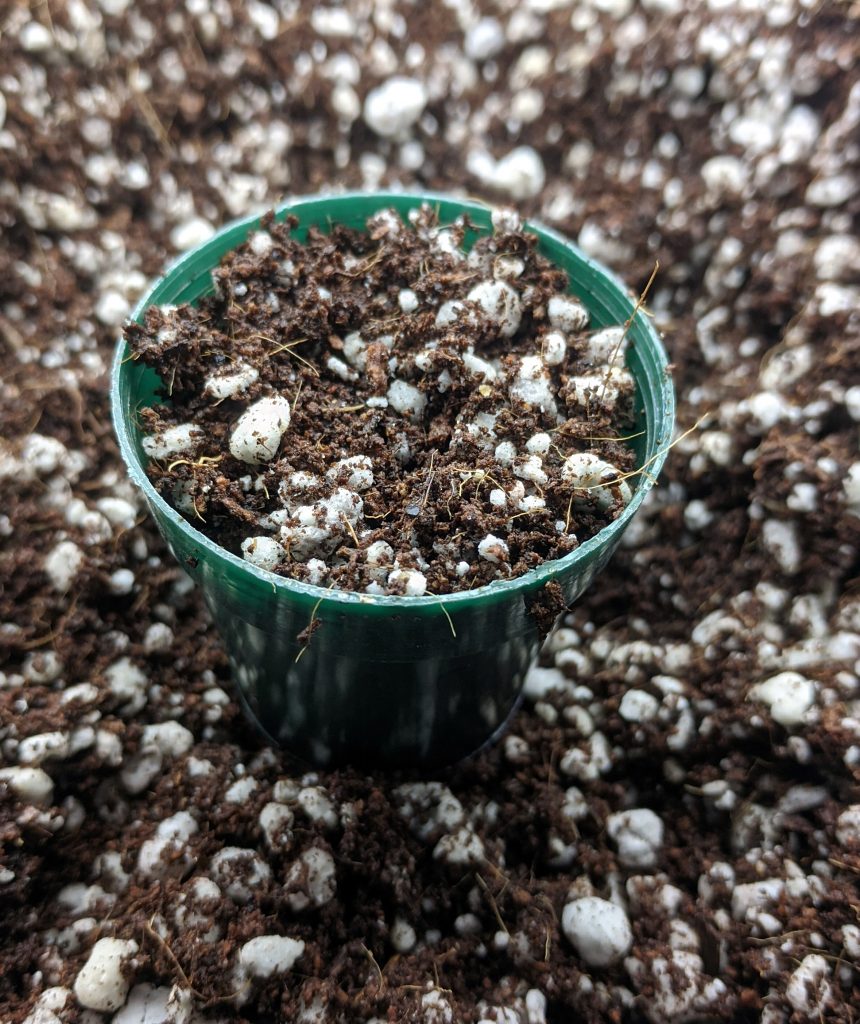
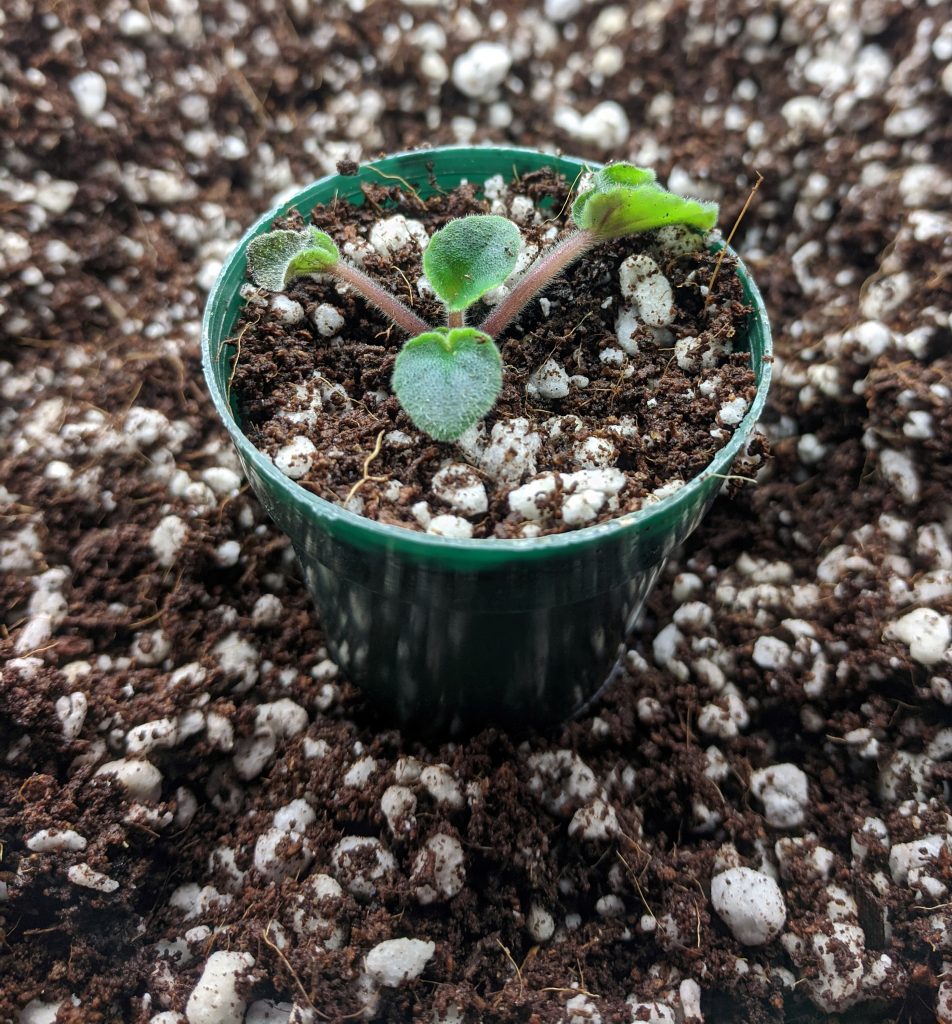
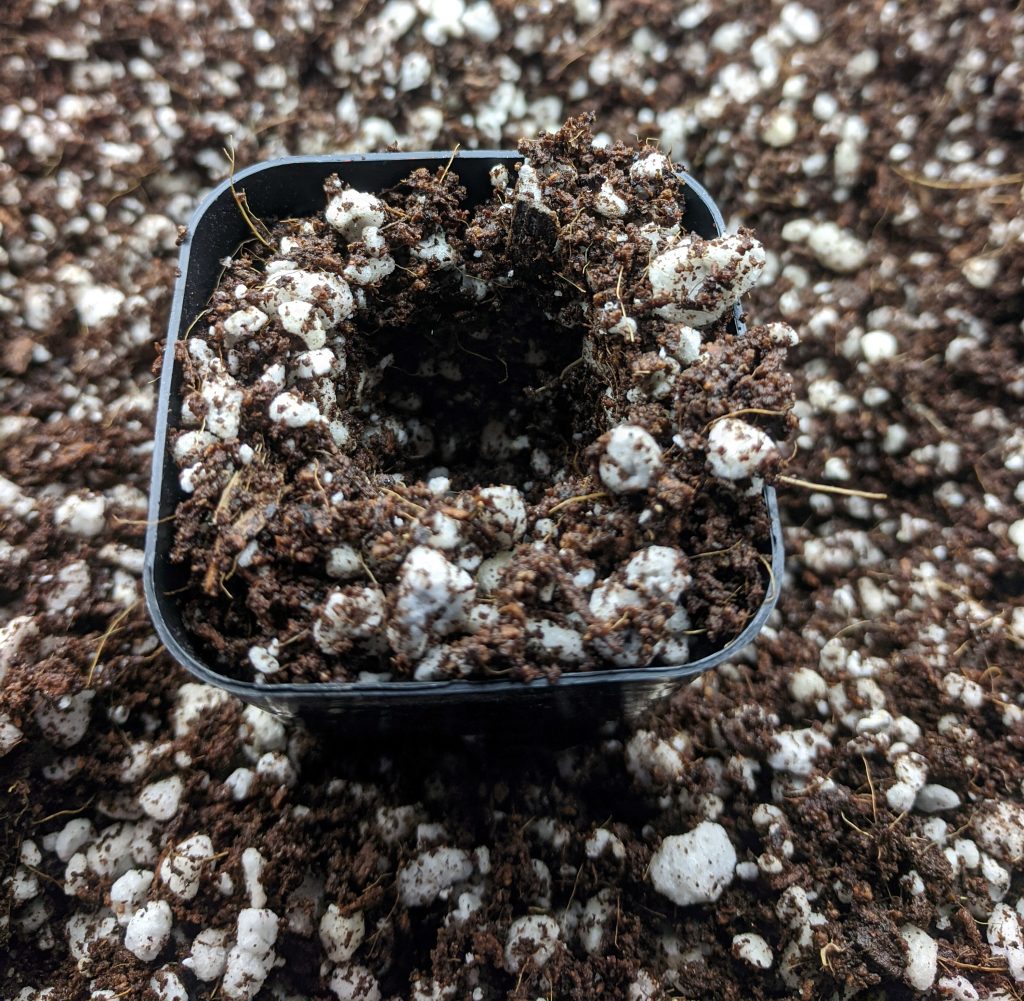
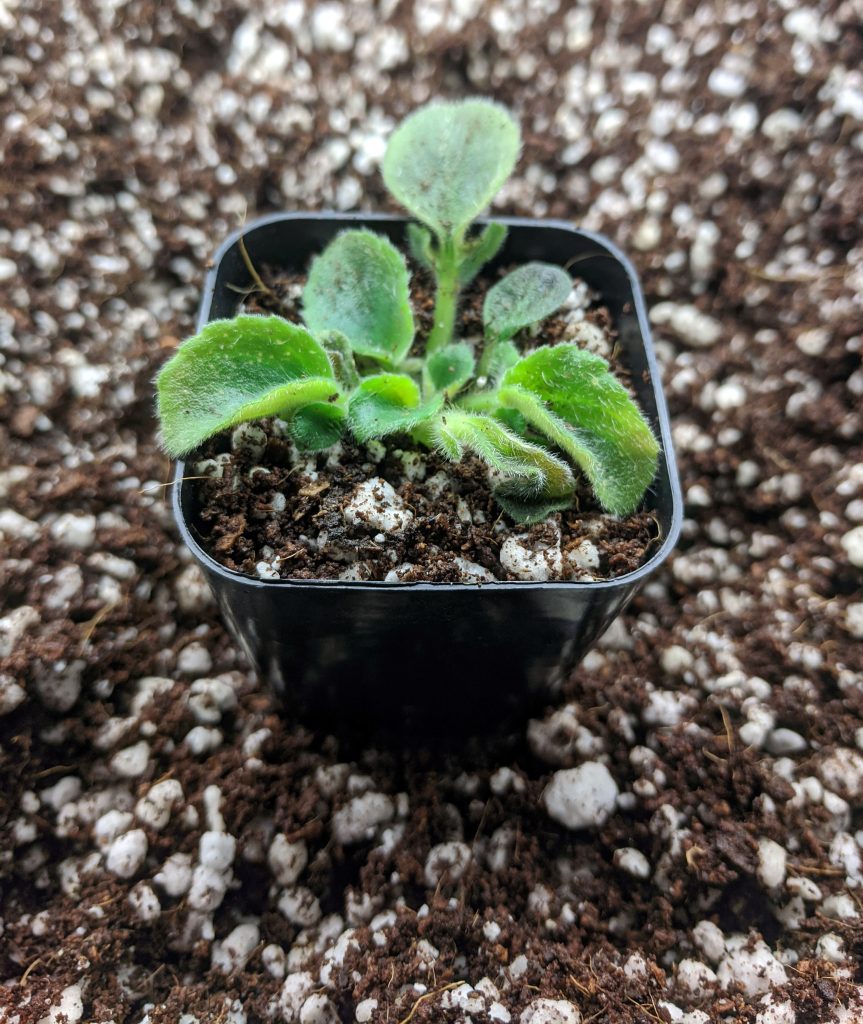
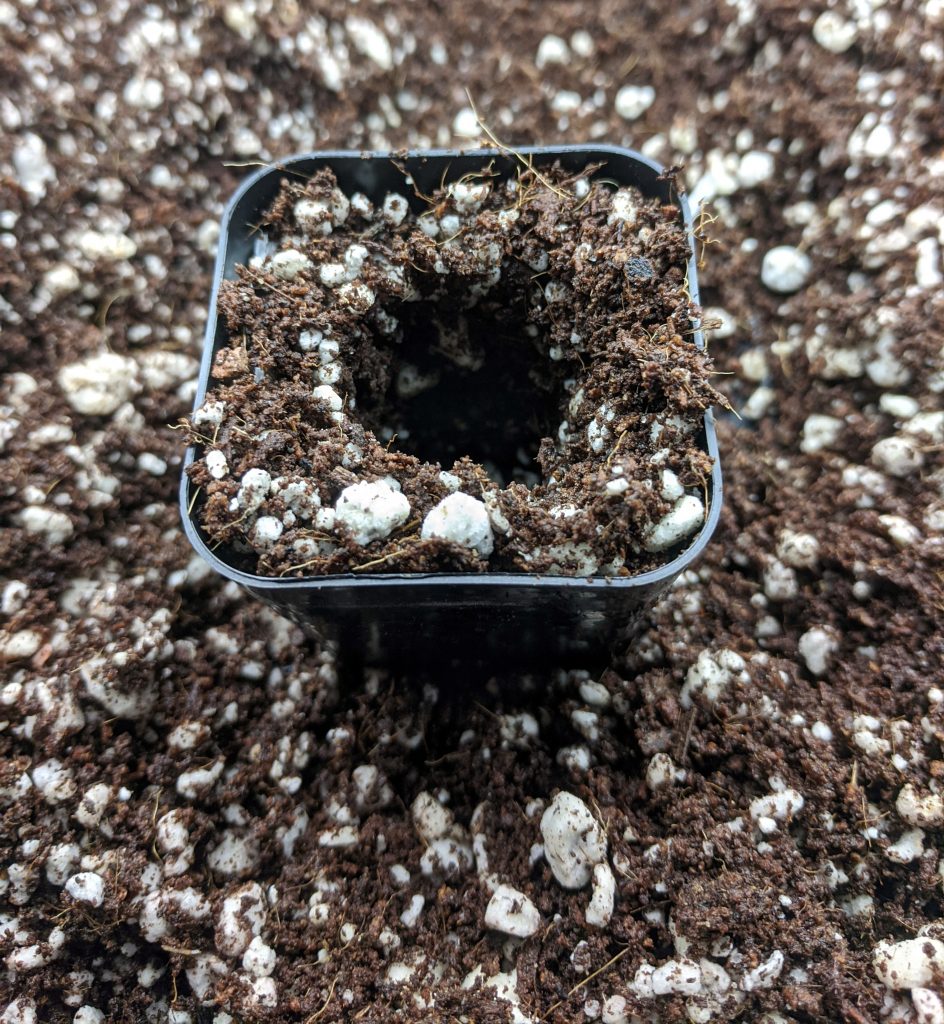
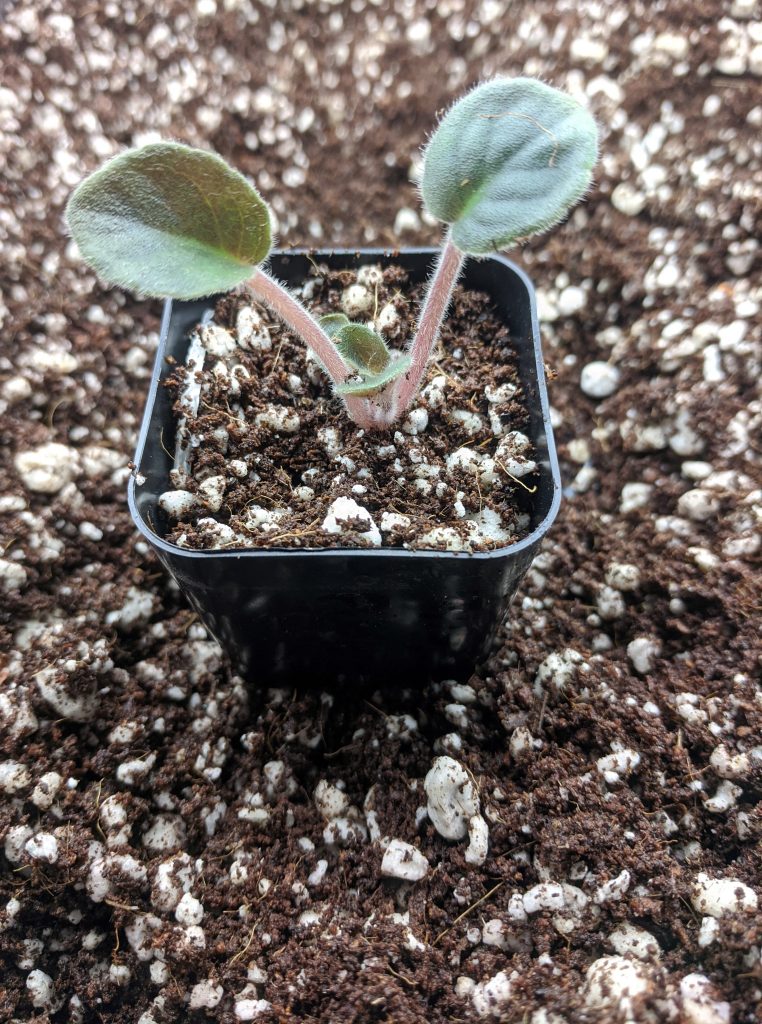
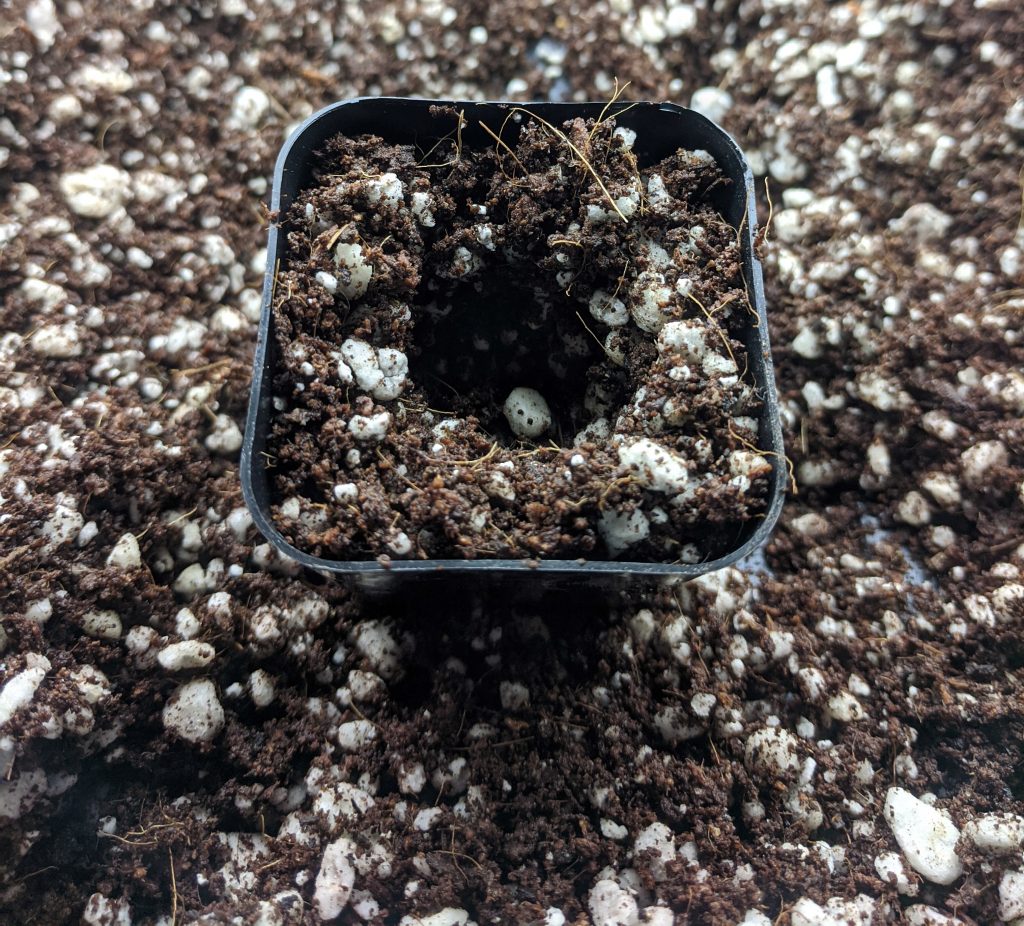
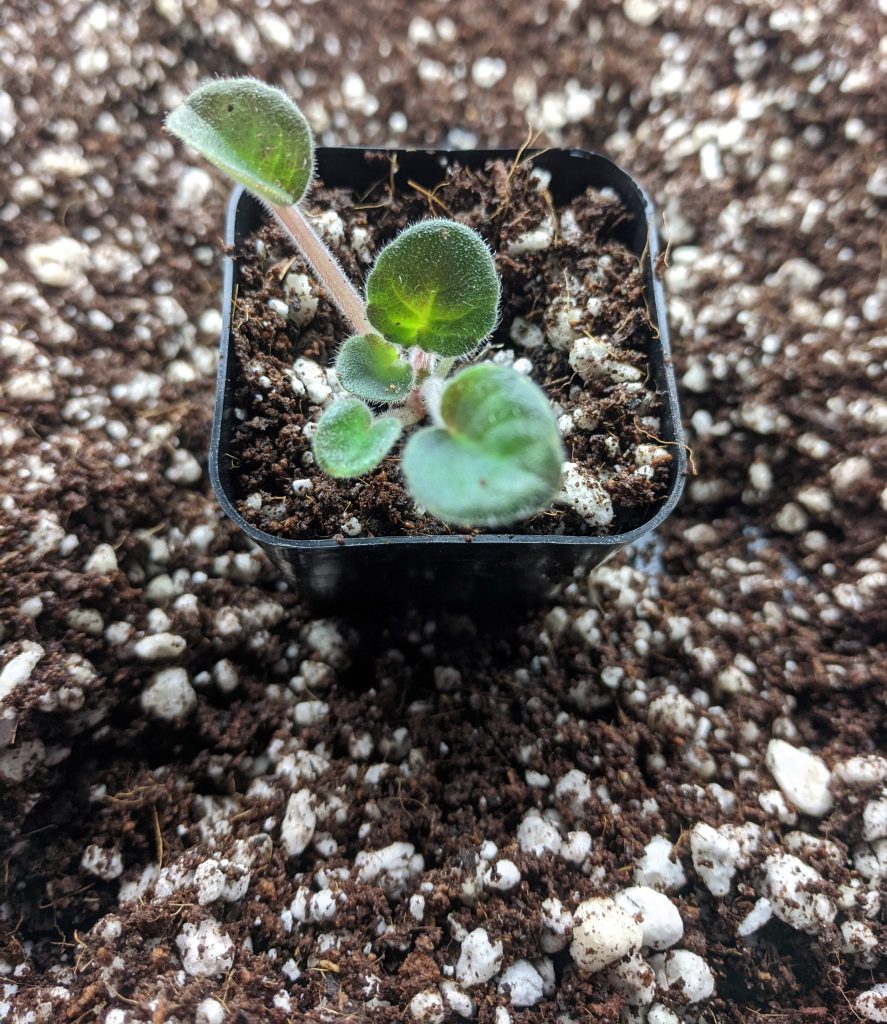
- If my plantlets are on the tiny side, I will sometimes plant 2-3 tiny baby plantlets into one small pot.
- As seen in the pictures below.
- This gives them a good support system to grow all their roots together in a single pot.
- I will leave this pot for 1-2 months till the plantlets grow larger in size and then I will separate them out into individual pots.
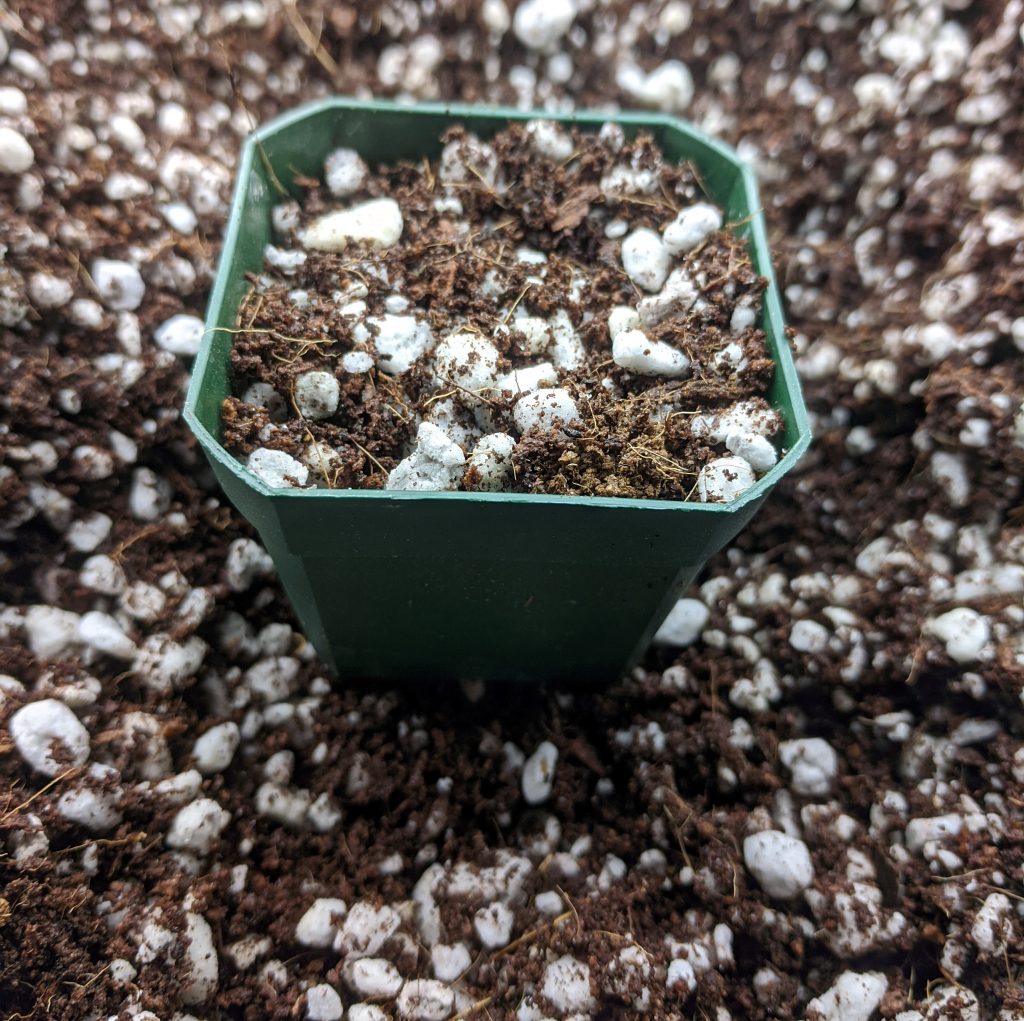
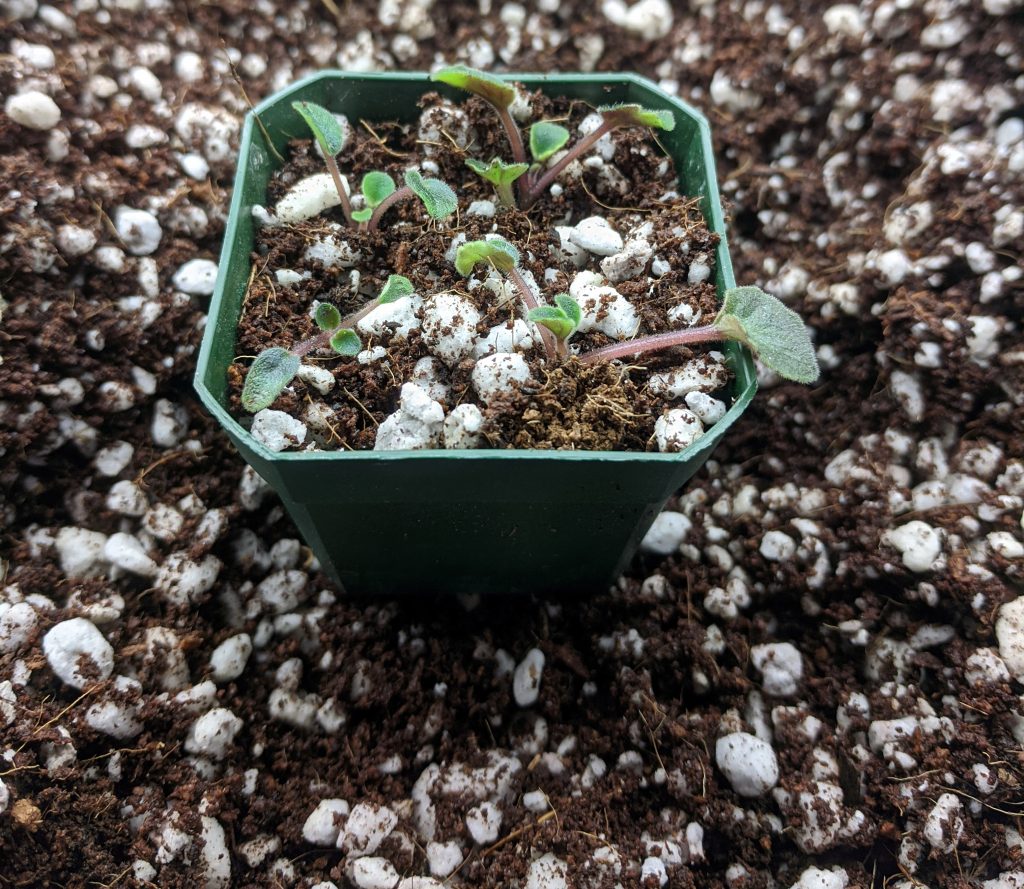
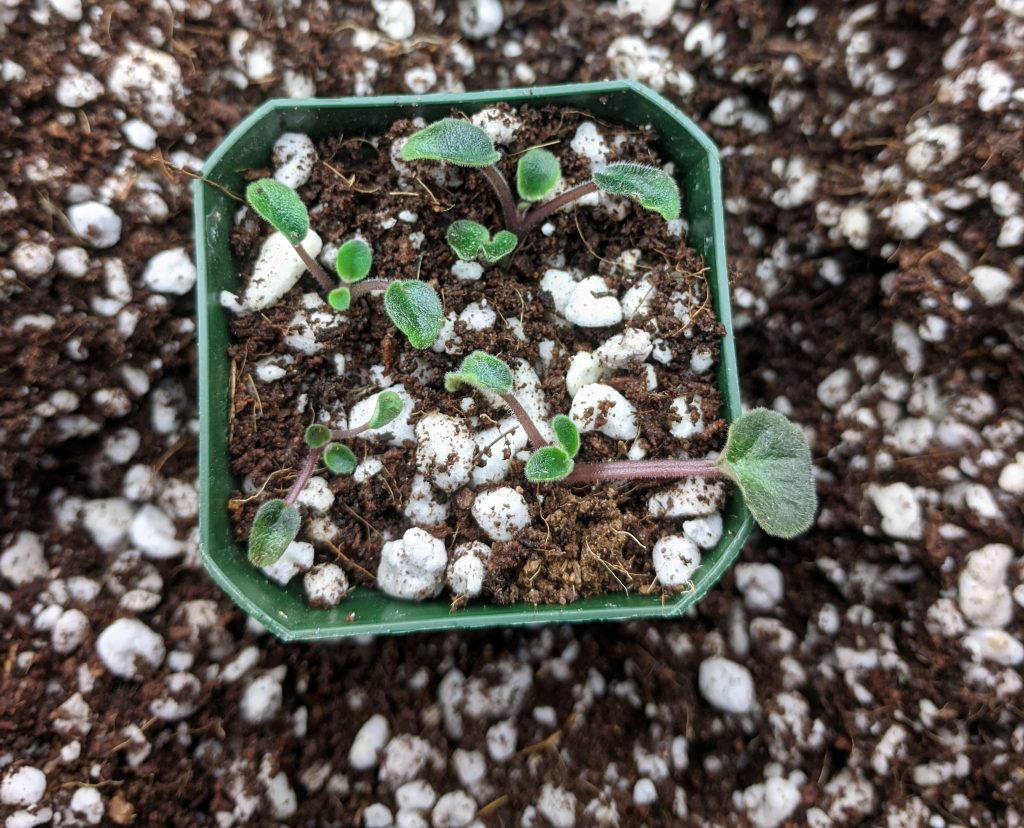
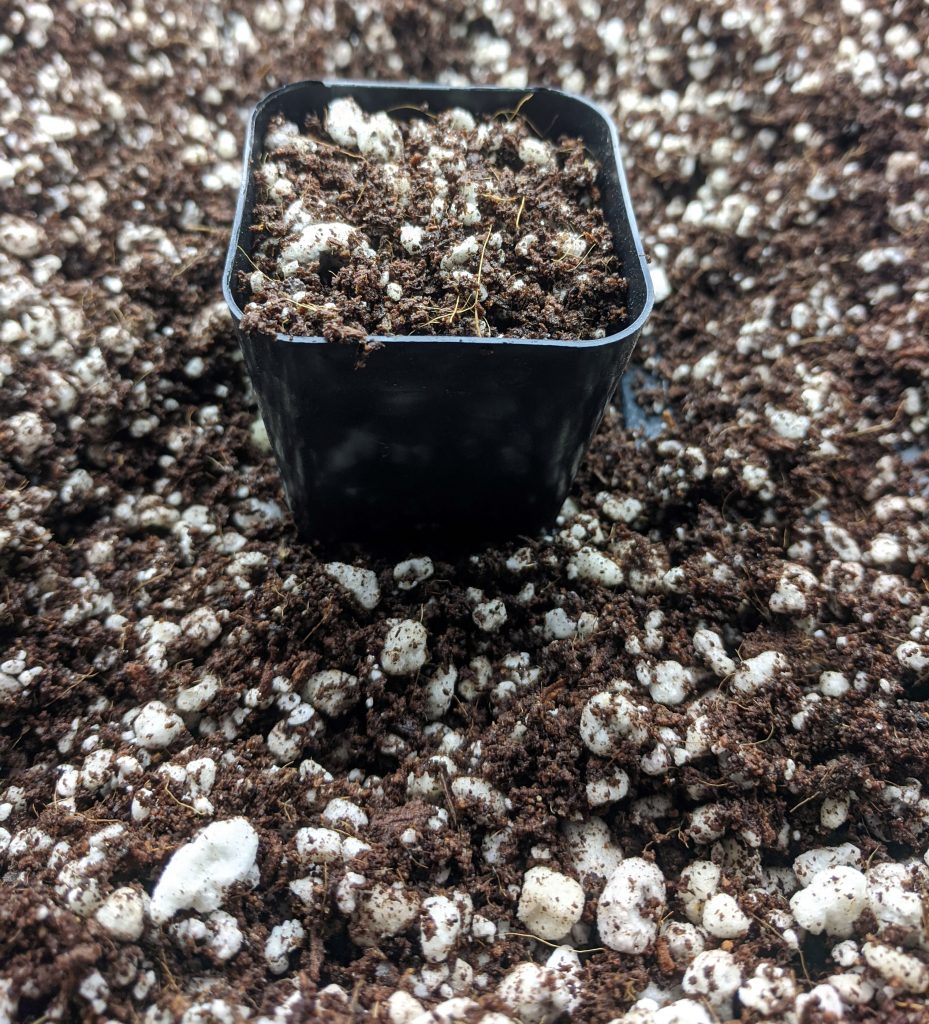
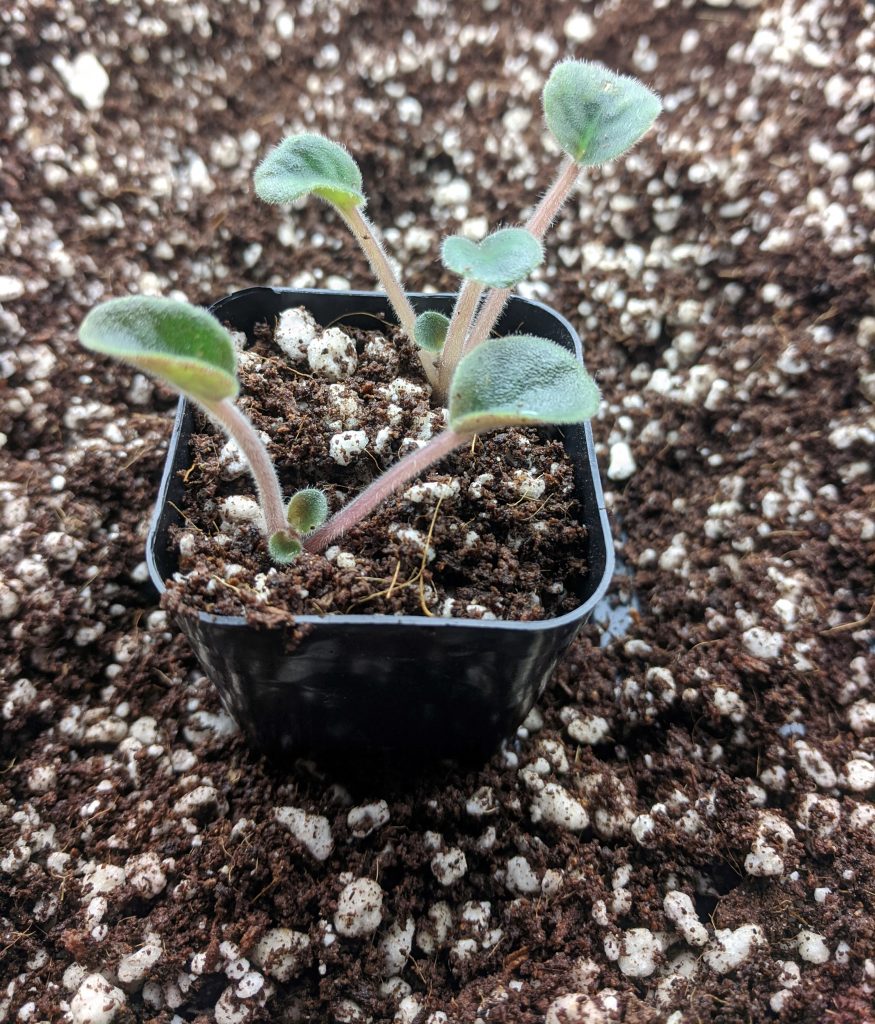
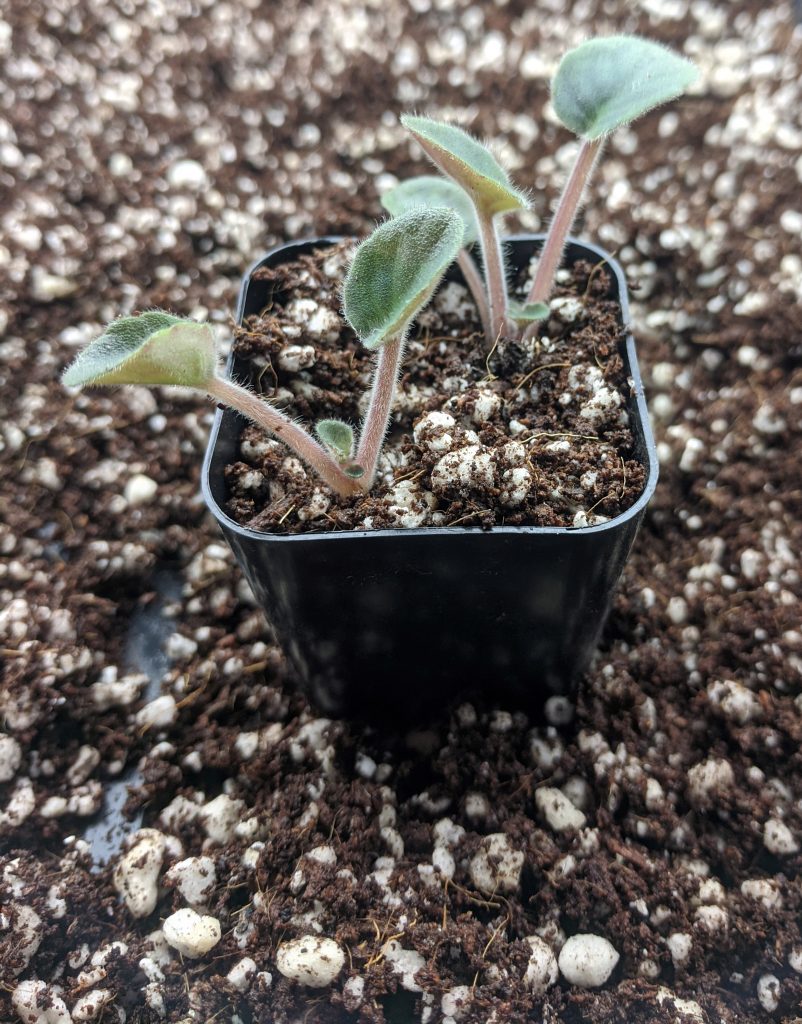
African Violet, perlite, coco coir and other potting mixes shown below:
How to take care of African Violet leaf baby plantlets until they are mature?
- Once you have potted up all your baby plantlets, they can go back into the high humidity environment.
- This will encourage strong root growth in the newly potted up soil.
- You can either put the pots in Ziploc baggies, your original plastic container or under humidity domes.
- Though, I do prefer individual Ziploc bags over the humidity domes.
- I think the smaller environment of the Ziploc bags gives you more control over watering and fertilizing over the larger domes, where too many plants are exposed to each other.
- Remember to regularly fertilize the plantlets. Continue at a diluted
fertilizeras you had used for the leaf cuttings. For e.g. I dilute 1/4tsp of my 7-7-7 fertilizer in 1 gallon of water. - For information on foliar feeding baby plantlets, can visit blog post, “Foliar Feeding African Violet Plants“.
- After a month, you can start fertilizing the plantlets with regular fertilizer, do this slowly, that is one a month or every alternate watering.
- Keep the plantlets in a high humidity environment for at least 2-3 months.
- Then acclimatize them to your normal plant room conditions by slowly opening up the Ziploc baggie over time.
- This can take a month, every week open up the baggie more and then leave the plantlets in an open baggie for a week before removing the pot completely out of the baggie into your open tray or stand.
- Yes it is a long process from start to finish, but do not lose hope! Best of Luck!
Ceramic pots or larger plastic pots with different designs, can be used as a nice outer container for your African Violet plants, as shown below:
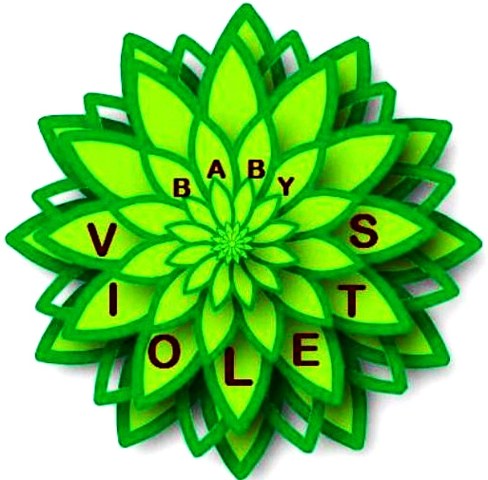
*Our Affiliate Programs: We are a participant in the Amazon Services LLC Associates Program, an affiliate advertising program designed to provide a means for us to earn fees by linking to Amazon.com and affiliated sites.
Though we do link to many items on Amazon out of convenience to our readers, we do also participate in other affiliate programs that also pay us a commission for any purchases you might make through our links (at no additional cost to you!).
Like this article?
Share on Facebook
Share on Twitter
Share on Linkdin
Share on Pinterest


13 Responses
My dears, thanks very much for the valuable information, i found these information very good. I had started my African violet from one leaf, now I have many plants, which giving me flowers most of the year. But I facing a problem of the soil. I am living in Istanbul – turkey, and I am using only pot ground ( that is only what I found in the markets) and I know that is a bad thing for the roots, so I shift to growing African violets in water only (hydropnic horticulture), using fertilizer in the minimum account. This gives me good flowers with healthy plants. Last year I mixed sea sand with the pot ground, but it did not gave me the results which I have expected. I do like I can provide you with some photos.
Thanks again and best regards
Hello Imad,
thanks for your message and kind words. Sure you can definitely sent pictures at ” babyvioletss@gmail.com “.
regards,
BV
I progated trailing voilets. I went to repot them . My first time . I took them out of pot and saw they where clumped together in many crowns. Not knowing I separated all the plants and repot each crown. I know feel that was all wrong. On trailing violets you do not separate crowns? Plant the in bunches?Now what will happen to these separated crowns that I planted?
Hello Sandra,
thank you for your question. It’s ok if you separated the plants and re-potted each crown, sometimes trailing violets need a little bit of grooming. Yes, you are right, for the most part trailing violets grow as multiple crowns. However if too many crowns are growing and the lower underneath leaves are getting crowded out, its good to remove a few crowns. The separated crowns, will grow into individual trailing plants. You will have a bunch of new trailing plants. Your original plant will be fine too, it will develop new crowns over time. They will look like small suckers and then develop into smaller crowns. You can place the newly potted up crowns, in a ziploc baggie or humidity dome, the increased humidity can help with rooting of the crowns. Can leave in bag for a month, then open up, allow plants to get used to outside environment for another 2 weeks, then remove from bag. If the plants get too moist, or the inside of the bag develops condensation, you can open up the bag, wipe the extra moisture droplets from the inside of the bag and close up again. Next time, when you re-pot a trailer, can repot like a regular violet, no need to remove the crowns, just pot up the main crown stem and leave the side growing crowns. You can groom a little, by removing any older/smaller/brown / dried leaves or if it has too many crowns and is top heavy, can remove a crown or two too. Hope this helps, regards, BV
I have do love African Violets. I have recently started a new collection of Violets. I cut a leaf from a newly purchased plant to get more plants started. I had the saucer from a pot so I just filled it with water and laid the leaf on the side of the saucer with the end in the water. Very shortly new roots formed and now I have 4-5 plantlets formed on the Mother Leaf. I put it in soil, but am about to divide them soon. Excited they formed roots so soon in water.
Hello Shirley,
thank you for the update on your leaf experiment. Wow! it seems to have worked out well, great to hear! regards,BV
It worked! I cut two leaves from the mother plant, dipped in rooting gel and planted both in the same small 3″ seedling pot, under a humidity dome. Now I have a multitude of babies from each leaf start. I will wait for one more month to repot them in your suggested 50/50 mix of peat perlite mix. Your instructions are very clear and concise. Wishing you the best,
Karla
That’s great to hear Karla!. So happy the leaf propagation technique worked out well for you. Thank you for your kind words.
I have some new plantlets coming up but a few of them have all pink or all white leaves. I know some green is necessary for photosynthesis. Will these colored plantlets grow some green eventually?
Hello Jackie, thank you for your question. Yes, they will grow green eventually. The plant will grow slower then your green leaf ones. As the weather warms up, the green should return to your plants. BV
Very helpful site; easy to read and understand.
Growing plantlets for the 1st time. Started 10 leaves in soil March 17. Today is May 23 and have a few plantlets with leaves the size of a nickel, but most leaves are smaller. Will wait till there are a few more leaves the size of a nickel. Thanks again!
Hello, my African Violet had a baby who is now the same size as the mother plant. Finally I’ve taken a picture to show, if necessary. Am I supposed to separate the two?
Hello Katherine,
Yes if they are both the same size plant, then you can go ahead and separate the two.
regards,
BV